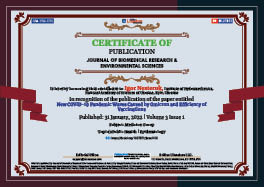Igor Nesteruk* and Oleksii Rodionov
Volume3-Issue1
Dates: Received: 2022-01-27 | Accepted: 2022-01-31 | Published: 2022-01-31
Pages: 114-139
Abstract
The sharp increase in the number of new COVID-19 cases in late 2021 and early 2022, which is associated with the spread of a new strain of coronavirus - omicron - is of great concern and makes it necessary to make at least approximate forecasts for the pandemic dynamics of the epidemic. As this rapid growth occurs even in countries with high levels of vaccinations, the question arises as to their effectiveness. The smoothed daily number of new cases and deaths per capita and the ratio of these characteristics were used to reveal the appearance of new coronavirus strains and to estimate the effectiveness of quarantine, testing and vaccination. The third year of the pandemic allowed us to compare the pandemic dynamics in the period from September 2020 to January 2021 with the same period one year later for Ukraine, EU, the UK, USA, India, Brazil, South Africa, Argentina, Australia, and in the whole world. Record numbers of new cases registered in late 2021 and early 2022 once again proved that existing vaccines cannot prevent new infections, and vaccinated people can spread the infection as intensively as non-vaccinated ones. Fortunately, the daily number of new cases already diminishes in EU, the UK, USA, South Africa, and Australia. In late January - early February 2022, the maximum averaged numbers of new cases are expected in Brazil, India, EU, and worldwide. Omicron waves can increase the numbers of deaths per capita, but in highly vaccinated countries, the deaths per case ratio significantly decreases.
Highlights: Vaccinated persons can get and pass the new coronavirus variants. The probability of death is much lower for vaccinated persons.
FullText HTML
FullText PDF
DOI: 10.37871/jbres1410
Certificate of Publication

Copyright
© 2022 Nesteruk I, et al. Distributed under Creative Commons CC-BY 4.0
How to cite this article
Nesteruk I, Rodionov O. New COVID-19 Pandemic Waves Caused by Omicron and Efficiency of Vaccinations. J Biomed Res Environ Sci. 2022 Jan 31; 3(1): 114-139. doi: 10.37871/jbres1410, Article ID: JBRES1410, Available at: https://www.jelsciences.com/articles/jbres1410.pdf
Subject area(s)
References
- Nesteruk I. Coronasummer in Ukraine and Austria. ResearchGate. 2020. doi: 10.13140/RG.2.2.32738.56002.
- Nesteruk I. COVID19 pandemic dynamics. Springer Nature. 2021. https://bit.ly/3HkKcBl
- Nesteruk I. Detections and SIR simulations of the COVID-19 pandemic waves in Ukraine. Comput Math Biophys. 2021;9:46-65. doi: 10.1515/cmb-2020-0117.
- World Health Organization. “Coronavirus disease (COVID-2019) situation reportsâ€. https://bit.ly/3s572GH
- COVID-19 Data Repository by the Center for Systems Science and Engineering (CSSE) at Johns Hopkins University (JHU). https://bit.ly/3oexblz
- Nesteruk I, Rodionov O, Nikitin A.V, and Walczak S. Influences of seasonal and demographic factors on the COVID-19 pandemic dynamics. EAI Endorsed Transactions on Bioengineering and Bioinformatics. 2021. doi: 10.4108/eai.8-12-2021.172364.
- Nesteruk I. Comparison of the COVID-19 pandemics dynamics in Ukraine and Israel in the summer of 2021. ResearchGate (Preprint). 2021. doi: 10.13140/RG.2.2.29989.22249.
- Nesteruk I. Influence of Possible Natural and Artificial Collective Immunity on New COVID-19 Pandemic Waves in Ukraine and Israel. Explor Res Hypothesis Med. 2021 Nov 11. doi: 10.14218/ERHM.2021.00044.
- Nesteruk I, Rodionov O. Impact of Vaccination and Testing Levels on the Dynamics of the COVID-19 Pandemic and its Cessation. J Biomed Res Environ Sci. 2021 Nov 23;2(11):1141-1147. doi: 10.37871/jbres1361.
- Nesteruk I. Final sizes and durations of new COVID-19 pandemic waves in Ukraine and around the world predicted by generalized SIR model. MedRxiv. 2021. doi: 10.1101/2021.11.22.21266683.
- Nesteruk I. Final sizes and durations of new COVID-19 pandemic waves in Poland and Germany predicted by generalized SIR model. MedRxiv. 2021. doi: 10.1101/2021.12.14.21267771.